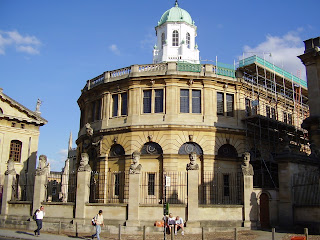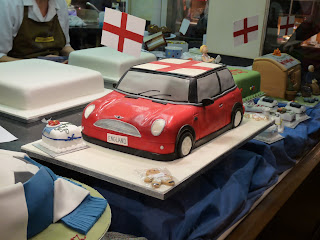
Chesham Station
The subject of this piece has a connection to the previous one about the first Country House in the Moderne style, High and Over 3 miles away in Amersham-on-the-Hill and Sir John Betjeman’s Metroland as they both featured in that famous documentary. Chesham is at the end of the title sequence for this is where the “Met” train comes to a halt at the end of the opening sequence.
http://daithaic.blogspot.com/2010/05/high-and-over-amersham.html
If you're not familiar with the county of Buckinghamshire, it's something of a surprise to arrive at a small country town and find signs for the London Underground - the instantly recognisable roundel, a circle with a line running through it. At Chesham's charming little station you can board a tube train and travel 25 miles (40.2km) to Aldgate in the City of London via places like Finchley Road, Northwood Hills, Wembley Park and Pinner - the heart of Metroland.The Chesham branch of the Metropolitan Line is as far removed from city life as is possible to get on London Underground.
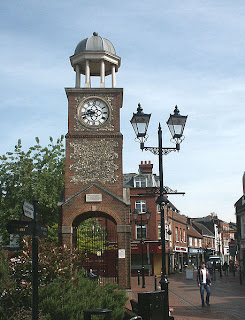
Chesham Town Clock in the Market Square
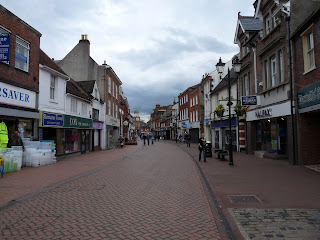
Chesham High Street
Chesham is a market town in the Chiltern Hills, Buckinghamshire, England. It is located 11 miles south-east of the county town of Aylesbury. Chesham is also a civil parish designated a town council within Chiltern district. It is situated in the Chess Valley and surrounded by farmland, as well as being bordered on one side by Amersham and Chesham Bois. The earliest records of Chesham as a settlement are from the second half of the tenth century although there is archaeological evidence of people in the area from around 8000 BC. The town is known for its four Bs, usually quoted as:- boots, beer, brushes and Baptists, . Chesham's prosperity grew significantly during the 18th and 19th centuries with the development of manufacturing industry. Chesham Building Society, the oldest such society in the world opened for business in 1845.

Along the platform
It is probably true to say that there is no Tube Station on London Underground which its community more closely identifies with for the people of Chesham raised the funds to have the station built into the centre of town. It means that this small Buckinghamshire town straddling the valley of the River Chess which gives it its name is directly connected to the West End and City of London; indeed it has its own direct fast trains, the Chesham Flyers, which run “fast” into the City. Today Chesham has a population of 20,000 and won’t grow any further as it is surrounded by hills which are “Green Belted”, where development is prohibited to maintain green space around London. Indeed, as all the roads into Chesham are steeply sloping there are times in icy winter when the almost 4 miles of the “Chesham Branch” have been its lifeline to the outside world.

Chesham Shuttle formed of 4 carriages of Metroplitan A Stock
The line to Chesham was for a while the terminus of the Metropolitan Railway. When the Met pushed out from Harrow and Rickmansworth in the 1880s, Chesham was the destination. There were proposals to link on from Chesham to the main London Euston to Birmingham line around the Tring area. Indeed, some land north of Chesham station was acquired for this purpose. I wonder if Watkin the then Chairman of the Met had a wry smile to himself when the people of Chesham actually raised funds to locate the station in a more central location as opposed to the proposed station in the Waterside area. If Watkin already had plans to extend beyond Chesham, he must have been delighted to receive the funds from the good folk of Chesham to extend the railway to central Chesham. The line from Chalfont Road (now Chalfont & Latimer) was single track, it being double up to Chalfont. When the main line was diverted through Amersham to Aylesbury, the line to Chesham became a branch line.

London Underground's Metropolitan Line today Click for a larger image
Chesham lies at the end of a branch of the Metropolitan Line, which opened in 1889. Together with nearby Amersham, it's one of London Underground's furthest outposts. Work began on extending what was then known as the St John's Wood Line beyond central London during the latter years of the 19th century. By the mid-1880s the railway had become known as the Metropolitan, running 17½ miles (28km) from Baker Street. The plan was to continue the line all the way to Aylesbury, but financial problems restricted its extension at that time to Chesham. Chesham is in Travelcard Zone 9 (previously zone D). It is situated 25 miles (40.2km) North West of Charing Cross, making it the furthest station out from Central London anywhere on the London Underground network (using Charing Cross as a central point). It is also both the northernmost and westernmost London Underground Station. Chesham replaced Ongar as the farthest station when the latter closed in 1994.

The Ticket Hall
Most of the land for the new sections of railway was acquired from the Duke of Bedford and Lord Chesham, but the land for the final half mile (800m) of the Chesham branch was presented to the railway by local residents to enable a station to be built in the centre of the town instead of on the outskirts, as was originally planned. In May 1889 the people of Chesham were invited to inspect the branch and afterwards entertained to a banquet. Seven weeks later, the line from Rickmansworth to Chesham was opened. For the next three years, until the main line from Chalfont and Latimer Station to Amersham and Aylesbury was opened in 1892, Chesham was the Metropolitan's most northerly terminus.
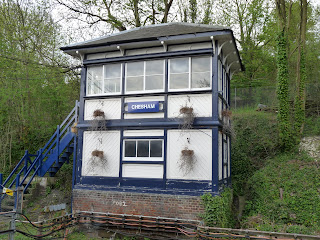
Chesham Signal Box
There were many plans to link the Town of Chesham with the railway network, including a branch by the LNWR off the main London to Birmingham line from Tring, but all these come to nothing. So it was left Edward Watkin, Chairman of the Metropolitan Railway to deliver the rail connection which the town needed. It also built a branch to Chesham in 1889 an important destination in its own right as well as aiming at an eventual link to the LNWR at Tring. Because of the plans for extension the station and the presence of the goods yard, Chesham used to have no fewer than three tracks (though only two platforms) and all three tracks remained well into the seventies (long after the yard was closed) as rather useless sidings. This three track layout may be clearly seen (in the early seventies) at the end of the opening credits of Metroland. Today there is only one platform and one track, the empty space that used to be platform one has now become a floral display.

Metropolitan Railway tank loco at Chesham
There is no station starter signal at Chesham. A set of co-acting signals are at the start of the Chesham branch

The Shuttle on the Branch
Chesham takes an inordinate pride in the “Chesham Flyers.” There are two 8-car through trains to Aldgate (during the morning rush hour) and two returning through trains in the evening rush hour but for most of the day a 4-car train operates as a shuttle service to and from Chalfont & Latimer station, on the main line to Amersham and Aylesbury. In February 2009, following a consultation the previous year, Transport for London announced that Chesham would have a regular through service to central London from 2011.
When steam was replaced on the Branch the then new A60 stock formed the rolling stock for the line (although other electric stock made an appearance in the early days of the electric service). A four car unit was used to form the shuttle to and from Chalfont. A new bay platform was built at Chesham to allow the shuttle train to be at Chesham when a through 8 car service was operating in the rush hour. This bay platform has been removed which means that if the through trains are late, the shuttle has to wait at Chalfont for the line to clear.
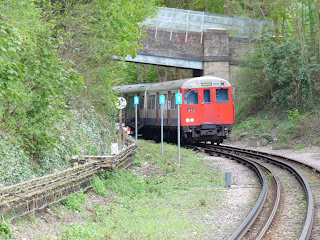
Leaving Chesham
Today the approach to Chesham is up from the High Street along an unprepossessing Station Road. The station buildings are small with a bench in the sheltered ticket hall and toilets and a bicycle store for commuters. London Underground’s obsession with “Capital” projects rather than staffing can be garnered from this short single platform boasting no less than 11 CCTV cameras. Whilst the station staffing hours are limited the shuttle drivers know many of the locals and have a definite bond with the line and the town. Indeed the friendly driver that day offered me a cab ride down to Chalfont and Latimer which unfortunately I couldn’t take up.
There are many relics of days gone by looking around the station. There are the derelict sandbox buffers on the abandoned bay siding, the water tank recalling when the steam trains filled up here and for a station without signals a very splendid “signal box.” But the eye is drawn down the track to the throat out of the station under a bridge and disappearing around the curve and this holds the secret of Chesham, a charming small town which is good to live in and grow up in connected to the “Big Smoke” by this unique, special, historic and still essential branch line.








